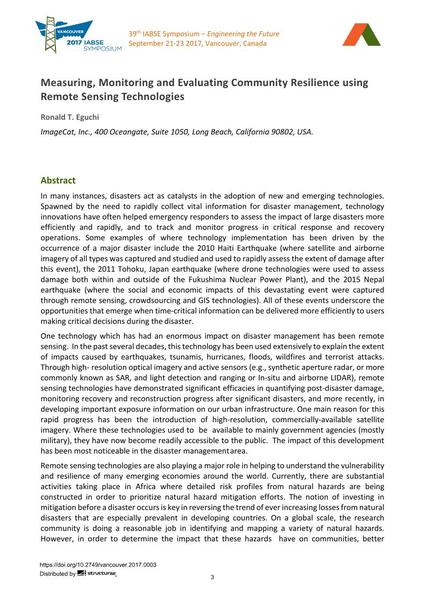Measuring, Monitoring and Evaluating Community Resilience using Remote Sensing Technologies

| Autor(en): |
Ronald T. Eguchi
(ImageCat, Inc., 400 Oceangate, Suite 1050, Long Beach, California 90802, USA.)
|
|---|---|
| Medium: | Tagungsbeitrag |
| Sprache(n): | Englisch |
| Tagung: | IABSE Symposium: Engineering the Future, Vancouver, Canada, 21-23 September 2017 |
| Veröffentlicht in: | IABSE Symposium Vancouver 2017 |
| Seite(n): | 3-4 |
| Jahr: | 2017 |
| DOI: | 10.2749/vancouver.2017.0003 |
| Abstrakt: |
In many instances, disasters act as catalysts in the adoption of new and emerging technologies. Spawned by the need to rapidly collect vital information for disaster management, technology innovations have often helped emergency responders to assess the impact of large disasters more efficiently and rapidly, and to track and monitor progress in critical response and recovery operations. Some examples of where technology implementation has been driven by the occurrence of a major disaster include the 2010 Haiti Earthquake (where satellite and airborne imagery of all types was captured and studied and used to rapidly assess the extent of damage after this event), the 2011 Tohoku, Japan earthquake (where drone technologies were used to assess damage both within and outside of the Fukushima Nuclear Power Plant), and the 2015 Nepal earthquake (where the social and economic impacts of this devastating event were captured through remote sensing, crowdsourcing and GIS technologies). All of these events underscore the opportunities that emerge when time-critical information can be delivered more efficiently to users making critical decisions during the disaster. One technology which has had an enormous impact on disaster management has been remote sensing. In the past several decades, this technology has been used extensively to explain the extent of impacts caused by earthquakes, tsunamis, hurricanes, floods, wildfires and terrorist attacks. Through high- resolution optical imagery and active sensors (e.g., synthetic aperture radar, or more commonly known as SAR, and light detection and ranging or In-situ and airborne LIDAR), remote sensing technologies have demonstrated significant efficacies in quantifying post-disaster damage, monitoring recovery and reconstruction progress after significant disasters, and more recently, in developing important exposure information on our urban infrastructure. One main reason for this rapid progress has been the introduction of high-resolution, commercially-available satellite imagery. Where these technologies used to be available to mainly government agencies (mostly military), they have now become readily accessible to the public. The impact of this development has been most noticeable in the disaster managementarea. Remote sensing technologies are also playing a major role in helping to understand the vulnerability and resilience of many emerging economies around the world. Currently, there are substantial activities taking place in Africa where detailed risk profiles from natural hazards are being constructed in order to prioritize natural hazard mitigation efforts. The notion of investing in mitigation before a disaster occurs is key in reversing the trend of ever increasing losses from natural disasters that are especially prevalent in developing countries. On a global scale, the research community is doing a reasonable job in identifying and mapping a variety of natural hazards. However, in order to determine the impact that these hazards have on communities, better information and data must be generated on exposures, i.e., what assets are at risk to these hazards. In the past several years, NASA has sponsored focused research on how to use earth observation (EO) imagery to delineate areas of urban development as well as the locations of critical infrastructure, e.g., roads, highways, bridges. Using a variety of satellite sensors (both active and passive) and combining this information with local field information (including census data), researchers have been able to construct inventories of buildings with regional profiles of building construction type, size and occupancy. This information has allowed analysts to quantify the expected damage or loss to communities from a wide range of natural hazards. These risk profiles are now allowing in-country policy makers to consider in a consistent and systematic way how best to address these risks for both urban and rural exposures. In summary, this presentation will show through examples how remote sensing technologies have changed the way in which we measure, monitor and evaluate community resilience to natural hazards worldwide. We will also discuss that even with this demonstrable progress, remote sensing technologies still have the potential to be even more valuable in enhancing resilience. For example, key areas of development include timely and affordable access to images around the world, ensuring robust methodologies for exposure development and risk analysis, adequate documentation of successes and failures with respect to the use and adoption of remote sensing technologies, and areas where government support – especially in the research area – is needed to design, develop and test methodologies, systems, platforms and other components, so that robust disaster management tools can be developed and deployed throughout the world. |
0.19 MB
- Über diese
Datenseite - Reference-ID
10298603 - Veröffentlicht am:
02.02.2019 - Geändert am:
27.04.2021



